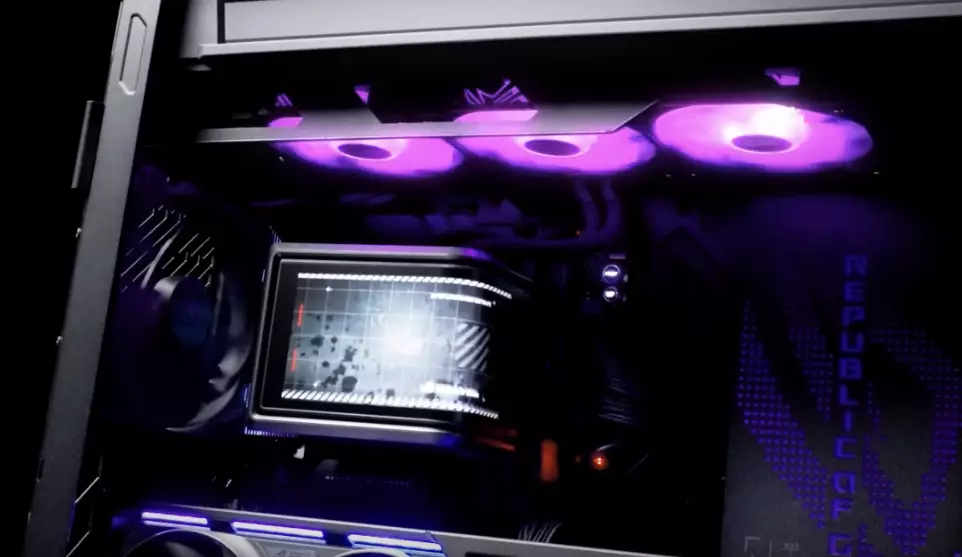In an era where visuals and personalized experiences are king, the ASUS ROG Ryuo IV series exemplifies how aesthetic innovation can reshape hardware design. Unlike traditional CPU coolers that prioritize mere functionality, this series introduces a curved, movable OLED screen capable of producing stunning 3D effects. It is a bold statement that graphics and sleek design are no longer optional but integral to high-end PC components.
What sets this cooler apart is not just its visual flair, but its commitment to pushing technology boundaries. The curved, battery-like display is not static; it can be repositioned on the unit, adding a layer of customization that appeals to enthusiasts eager to showcase their builds. This move towards interactive design signals a shift in user expectations—hardware should not only perform but also visually engage.
While some might dismiss this as superficial, there’s an inherent value in integrating vibrant screens that can display real-time system stats alongside dynamic visuals. The potential for this tech to evolve beyond novelty—serving as a live dashboard or immersive media hub—opens a new frontier for how we perceive and interact with PC components.
Performance and Practicality: Is It Worth the Price?
Beyond its eye-catching display, the ASUS ROG Ryuo IV 360 ARGB water cooler is a testament to high-performance engineering. With a pump designed to deliver enhanced flow and lower impedance, the system promises superior cooling, even under heavy workloads. Its compatibility with a wide range of sockets—LGA 1851, 1700, AMD AM5, AM4—ensures broad usability, making it a versatile choice for various builds.
Its robust design includes ample tubing, measured at 400mm, providing better clearance and chassis flexibility. The inclusion of meticulously designed ARGB fans, which balance high airflow with quiet operation, exemplifies the focus on user comfort and performance. However, these features come with a hefty price tag—over £300 in the UK—making this one of the most expensive CPU coolers on the market.
From a practicality standpoint, the investment raises questions. Does this cooler justify its cost simply through its visual innovations, or does it add tangible value to thermal performance? The answer lies in the eye of the beholder. Enthusiasts who prioritize aesthetics and display integration might see it as an indispensable part of a flagship build. Meanwhile, cost-conscious users are likely to weigh whether the visual spectacle is worth the premium.
Innovative Features That Signal a New Normal
The movable OLED screen is not just a gimmick; it embodies a new paradigm where hardware becomes an extension of personal expression. The ability to customize what the display shows—ranging from system stats to bespoke visuals—gives users control over their hardware narrative. This flexibility elevates PC building from a purely functional task into a form of digital artistry.
The “3D-effect” visuals supported by the AMOLED display offer an added layer of immersive appeal. Although not traditional lenticular 3D, these effects leverage clever graphics to evoke depth and movement, engaging viewers on an almost hypnotic level. This represents a trend towards integrating entertainment and information in ways previously reserved for gaming rigs, digital art displays, or high-end consumer gadgets.
On the technical side, ASUS’s approach highlights a broader industry trend: blending form and function by embedding customizable technology directly into cooling solutions. It’s a move that may set a precedent, inspiring other manufacturers to rethink how they approach not just aesthetics, but integrated hardware experiences.
The Cultural Shift Toward Elevated Hardware Aesthetics
The ASUS ROG Ryuo IV series symbolizes a cultural change—gamers and PC enthusiasts no longer see their components as merely functional items but as showcases of craftsmanship and personality. As hardware detail and customization become more prominent, the boundaries between tech and art are blurring.
Over time, these innovations could redefine expectations across the industry. Will future coolers feature even more interactive displays, or evolve into multi-purpose hubs? It’s a compelling possibility, suggesting that hardware advancements will increasingly focus on user engagement and visual storytelling.
This movement also signifies a shift in consumer willingness to invest in premium features—accepting higher costs in exchange for unique, personalized experiences. It’s a testament to how far we’ve come from simple cooling solutions to sophisticated, interactive art pieces integrated seamlessly into our digital lives.

